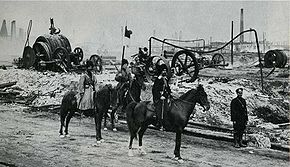| Revision as of 01:11, 9 February 2009 editShahin Giray (talk | contribs)123 edits it was called Nakhichevan in that time← Previous edit | Revision as of 01:13, 9 February 2009 edit undoShahin Giray (talk | contribs)123 editsm moved Armenian–Azerbaijani massacres 1905-1907 to Armenian–Tatar massacres 1905-1907: correct contemporary and scholarly term. also most common one used.Next edit → |
| (No difference) | |
Revision as of 01:13, 9 February 2009
| Armeno-Tartar War | |||||||
|---|---|---|---|---|---|---|---|
 A Cossack military patrol near the Baku oilfields, ca. 1905. | |||||||
| |||||||
The Armenian-Tatar massacres (also known as the Armenian-Tartar War and the Armeno-Tartar War) refers to the bloody inter-ethnic confrontation between the Armenians and Caucasian Tartars (modern Azerbaijanis) throughout the Caucasus in 1905—1907.
The massacres started during the Russian Revolution of 1905, and claimed hundreds of lives. The most violent clashes occurred in 1905 in February in Baku, in May in Nakhichevan, in August in Shusha and in November in Ganja, heavily damaging the cities and the Baku oilfields. Some violence, although of lesser scale, broke out also in Tbilisi.
-
 The house of a wealthy Armenian burnt down by Caucasian Tartars.
The house of a wealthy Armenian burnt down by Caucasian Tartars.
-
 An Armenian church plundered and desecrated by Caucasian Tartars.
An Armenian church plundered and desecrated by Caucasian Tartars.
-
 Monument in memory of the victims of 1905-1906 Armenian-Tatar Massacres in Berdadzor, Nagorno-Karabakh Republic
Monument in memory of the victims of 1905-1906 Armenian-Tatar Massacres in Berdadzor, Nagorno-Karabakh Republic
References
- Britannica Online Encyclopedia. Azerbaijan. History.
- Brockhaus and Efron Encyclopedic Dictionary. Turks
- Willem van Schendel, Erik Jan Zürcher. Identity Politics in Central Asia and the Muslim World: Nationalism, Ethnicity and Labour in the Twentieth Century. I.B.Tauris, 2001. ISBN 1860642616, 9781860642616, p. 43
- Villari, Luigi. Fire and Sword in the Caucasus. London: T. F. Unwin, 1906 ISBN 0-7007-1624-6 p. 285
- Villari. Fire and Sword, p. 290
Bibliography
- Thomas De Waal (2004), Black Garden: Armenia and Azerbaijan Through Peace and War, NYU Press, ISBN 978-0-8147-1945-9
External links
This Armenian history-related article is a stub. You can help Misplaced Pages by expanding it. |
This Asian history–related article is a stub. You can help Misplaced Pages by expanding it. |